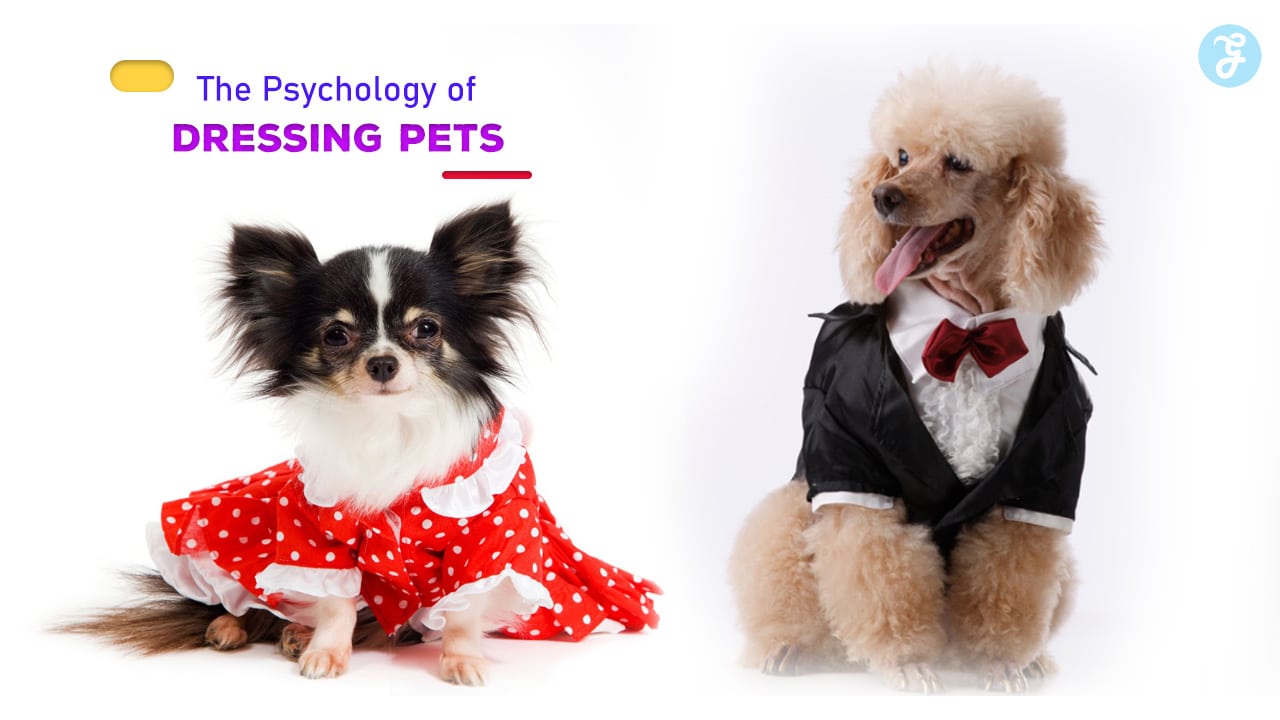The trend of dressing pets has skyrocketed in recent years, with pet owners across the world adorning their furry companions with everything from cute sweaters and Halloween costumes to practical raincoats and paw boots.
While dressing pets is often seen as a fun or fashionable activity, there’s much more to it than meets the eye. The act of dressing pets taps into deeper psychological factors related to human-animal relationships, pet welfare, and even animal behavior.
But is dressing pets purely for human enjoyment, or does it serve a purpose for the pets themselves?
In this in-depth guide, we’ll explore the psychology of dressing pets, highlighting the benefits it can offer as well as the considerations and potential concerns pet owners should be aware of.
Whether you’re an enthusiastic pet dresser or someone who’s curious about the practice, this article will provide valuable insights into how clothing impacts pets and their relationship with their human companions.
The Origins and Evolution of Dressing Pets
While dressing pets may seem like a modern trend, it actually has deep historical roots. Throughout history, humans have adorned animals with various forms of attire for both practical and symbolic reasons.
In ancient civilizations, pets and working animals were dressed to signify status, protection, or functionality. Fast-forward to today, and dressing pets has become a cultural phenomenon in many parts of the world, blending both function and fashion.
Historical Perspectives on Pet Attire
- Ancient Egypt: Cats, revered in Egyptian culture, were often adorned with jewelry as a symbol of protection and honor. While not dressed in clothing, the concept of “adorning” pets with items is ancient.
- Medieval Europe: In medieval times, dogs that accompanied nobility often wore collars and coats that signified their roles as hunting companions or guards. Functional items such as leather armor protected the animals in battle or during hunts.
- Modern Era: In the 20th century, pet clothing became more widespread as pets transitioned from working animals to beloved companions. The rise of pet fashion mirrored human fashion trends, with pet clothing becoming both functional (raincoats, booties) and decorative (costumes, sweaters).
Today, the practice of dressing pets is driven by both practical considerations, such as protection from the elements, and aesthetic enjoyment, reflecting the deep emotional connection between pets and their owners.
The Benefits of Dressing Pets
Dressing pets offers a variety of benefits, both for the animals themselves and their owners. While many people view pet clothing as a purely aesthetic or playful activity, there are numerous practical reasons why dressing pets can be beneficial.
Understanding these benefits is key to determining when and how it’s appropriate to dress pets.
1. Protection from the Elements
One of the primary benefits of dressing pets is protection from harsh weather conditions. Pets, particularly short-haired breeds or small animals, are more susceptible to the cold, rain, and heat. Clothing such as raincoats, sweaters, and boots can help keep pets warm, dry, and comfortable during outdoor activities.
- Cold weather: Breeds with thin coats, like Greyhounds or Chihuahuas, may struggle in cold temperatures. A sweater or jacket can help them maintain body heat, preventing hypothermia or discomfort.
- Rain and mud protection: Raincoats and waterproof booties keep pets dry and prevent them from tracking mud or water into the house after a walk.
- Heat protection: In hot climates, breathable fabrics can protect pets’ skin from sunburn, particularly for hairless breeds or pets with sensitive skin.
2. Reducing Anxiety and Stress
Dressing pets can have a calming effect on some animals, helping to reduce anxiety and stress. Similar to the effect of a weighted blanket on humans, certain types of pet clothing, such as snug-fitting shirts or jackets, can provide comfort by applying gentle pressure to the animal’s body.
This sensation can help soothe pets who are prone to anxiety, whether due to thunderstorms, fireworks, or separation from their owners.
- Anxiety wraps: Products like the Thundershirt apply gentle pressure, which can help alleviate stress in anxious dogs or cats.
- Calming effect: Pets that feel secure in their clothing may experience lower levels of stress during travel, vet visits, or noisy events.
3. Medical and Health Benefits
Pet clothing can also serve an important medical purpose for animals recovering from surgery or dealing with skin conditions.
In such cases, post-surgical garments or protective clothing can prevent pets from licking, scratching, or aggravating a wound or medical condition.
- Post-surgery recovery: Clothing can replace the traditional cone of shame, offering a more comfortable way to protect stitches or incisions.
- Skin protection: Pets with allergies or skin conditions may benefit from lightweight clothing that prevents them from irritating their skin through scratching.
4. Enhancing the Human-Pet Bond
For many pet owners, dressing pets strengthens the emotional connection they share with their animal companions.
By including pets in daily routines such as selecting clothing or dressing them for special occasions, owners create shared experiences that foster stronger bonds.
- Emotional connection: Dressing a pet can be a way for owners to express their affection and care, reinforcing their relationship with their pet.
- Social interaction: Pet clothing often sparks interactions with other pet owners, whether at the park or through social media, creating a sense of community and shared interest.
Psychological Considerations for Pets
While there are several benefits to dressing pets, it’s essential to recognize the psychological impact that clothing can have on animals. Each pet is unique, and what works for one may not be suitable for another.
Understanding the psychology of pets and how they perceive clothing is key to ensuring that the experience is positive rather than stressful.
1. Understanding Pet Behavior
Pets, particularly dogs and cats, communicate through body language and behavior. Clothing can sometimes interfere with their ability to express themselves naturally or make them feel uncomfortable.
For example, some pets may show signs of discomfort, such as pawing at the clothing, acting lethargic, or displaying unusual behavior after being dressed.
- Body language: It’s important to monitor your pet’s behavior after putting clothing on them. If they seem distressed or anxious, it may be a sign that the clothing is uncomfortable or too restrictive.
- Gradual introduction: For pets new to wearing clothing, introducing garments gradually and in short periods of time can help them adjust to the sensation.
2. Ensuring Comfort and Safety
Comfort and safety should always be top priorities when dressing pets. While clothing can offer protection, poorly fitted or inappropriate clothing can cause discomfort, restrict movement, or even lead to injury.
- Proper fit: Ensure that the clothing fits your pet properly—not too tight to cause discomfort or too loose to create a tripping hazard.
- Material selection: Choose breathable, lightweight materials for everyday wear, and avoid fabrics that may cause allergies or irritation to the skin.
3. Avoiding Anthropomorphism
It’s important to avoid anthropomorphizing pets—projecting human emotions and behaviors onto animals—when it comes to dressing them.
While humans may enjoy fashion and self-expression through clothing, pets have different needs and preferences. Dressing pets solely for aesthetic or social media purposes without considering their comfort or well-being can lead to negative experiences for the animal.
- Respecting individuality: Every pet has a unique personality and tolerance for clothing. Some pets may enjoy wearing clothes, while others may dislike it. Respect your pet’s preferences and never force them to wear clothing for human entertainment.
Dressing Different Types of Pets: Dogs, Cats, and Beyond
While dogs are the most commonly dressed pets, other animals, such as cats and even small mammals, are also sometimes dressed in clothing.
However, the psychological impact of clothing may vary significantly across different species, and what works for a dog may not be suitable for a cat or rabbit.
Dressing Dogs: Practical and Social Considerations
Dogs tend to be more adaptable when it comes to wearing clothing, especially if they’re introduced to it gradually.
Many dogs enjoy the attention and comfort that comes with being dressed in a cozy sweater or jacket, particularly in colder climates. However, it’s important to balance practicality with the dog’s comfort and personality.
- Functional clothing: Many dogs benefit from raincoats, boots, and jackets designed to protect them from the elements. These items can enhance their outdoor experiences while keeping them warm and dry.
- Special occasions: Dressing dogs in costumes for events like Halloween or birthdays can be a fun way to include them in celebrations, but it’s essential to ensure that the costume is safe and comfortable.
Dressing Cats: A Delicate Balance
Cats, on the other hand, are generally less tolerant of clothing. As independent animals, they may find clothing restrictive or uncomfortable.
However, some cats may tolerate certain garments, particularly if the clothing serves a practical purpose, such as protection from the cold or post-surgical care.
- Gradual introduction: Cats should be introduced to clothing slowly, and it’s important to observe their behavior closely to ensure they’re not stressed.
- Post-surgical clothing: Cats recovering from surgery may benefit from protective clothing that prevents them from licking or biting at wounds.
Dressing Small Pets: Hamsters, Rabbits, and More
Dressing small mammals, such as rabbits, hamsters, or guinea pigs, is generally discouraged due to the stress and discomfort it can cause. These animals have delicate bodies, and clothing can restrict their movement, making them feel unsafe.
- Stress factors: Small animals are more sensitive to environmental changes, and dressing them in clothing can heighten their stress levels. It’s best to avoid dressing small pets unless absolutely necessary for medical reasons.
The Rise of Pet Fashion and Social Media Influence
Pet fashion has become a global trend, with pet owners showcasing their pets’ wardrobes on social media platforms like Instagram, TikTok, and Facebook.
The rise of pet influencers has created a booming industry around pet clothing, with brands catering to everything from casual wear to high-end pet fashion.
The Impact of Pet Influencers
- Social media fame: Pets dressed in fashionable outfits often attract large followings on social media, leading to opportunities for sponsorships and brand partnerships.
- Pet fashion brands: The growth of the pet fashion industry has led to the development of specialized brands offering everything from seasonal collections to custom-designed outfits for pets.
While pet fashion can be a fun way to celebrate your pet’s personality, it’s essential to ensure that the animal’s well-being is prioritized over aesthetics.
Ethical Considerations in Dressing Pets
While there are clear benefits to dressing pets for practical reasons, there are also ethical considerations to keep in mind. Pet owners must balance their desire to dress their pets with the animal’s comfort, safety, and psychological well-being. Ethical pet ownership involves making decisions that prioritize the pet’s needs over human desires.
Key Ethical Questions to Consider
- Is it necessary?: Ask yourself whether dressing your pet serves a functional purpose, such as protection from the weather or medical recovery, or whether it’s purely for entertainment.
- Does my pet enjoy it?: Pay close attention to your pet’s behavior and body language when dressed. If they seem distressed or uncomfortable, it’s best to forgo the clothing.
- Health and safety: Always ensure that any clothing or accessories you use are safe for your pet and do not pose a choking or tripping hazard.
By considering the ethical implications of dressing pets, owners can ensure that their furry companions are happy, healthy, and comfortable.
Conclusion
The psychology of dressing pets is a complex and multifaceted topic, with both benefits and considerations that pet owners should take into account.
While dressing pets can offer protection, reduce anxiety, and strengthen the human-pet bond, it’s important to ensure that the experience is positive for the animal.
By understanding pet behavior, prioritizing comfort and safety, and making ethical decisions, pet owners can enjoy dressing their pets while fostering a healthy and loving relationship.
Ultimately, dressing pets should be about enhancing their well-being, not just for human enjoyment. With thoughtful consideration, pet owners can strike the right balance, ensuring that their furry friends are both stylish and happy.







































